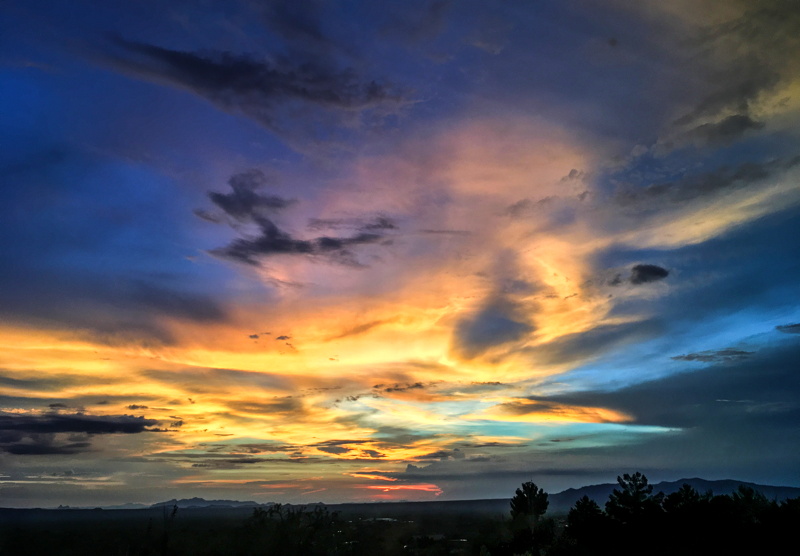More Weather Updates;
Sun Imaging Tests
Posted: 26 July 2017
Wednesday, 12 July 2017, dawned with mostly clear skies. Monsoon weather pattern buildups began late morning, with the sky becoming mostly cloudy by early afternoon. Shortly after sunset a brief monsoon thunderstorm arrived with strong winds, lots of lightning, and heavy rain. Received 0.26" rain in about 30 minutes with a total of 0.32" from our first good thunderstorm for this year's Monsoon Season.
Thursday, 13 July, was mostly cloudy. Had a severe thunderstorm about sunset. Rotating clouds, lots of lightning, brief heavy rain (0.22"), wind! with another monsoon thunderstorm in the evening (0.22" rain). Friday, 14 July, was cloudy with another monsoon thunderstorm before sunset (0.08"). Even had a rare Tornado Warning in the county:

There was a confirmed landspot tornado a few minutes after the warning was put out. It was not near Oracle however.
Saturday, 15 July, started out partly cloudy. I was able to complete my review of the Kendrick Self Adhesive Sun Finder. Another late afternoon monsoon thunderstorm occurred:

Somebody got a lot of rain from this storm but all we got was continuous thunder and a few raindrops. Later that night another thunderstorm came through with some brief heavy rain (but only 0.07").
The sky was clear Sunday morning, 16 July, but clouds began building mid-morning due to the current monsoon weather pattern. Had several tame thunderstorms beginning in the afternoon (but with a total rain of 0.29"). Monday was cloudy and with several loud thunderstorms (0.27"). This is a big one to the west that just missed us (vertical panorama from western horizon to zenith):

Click or tap on image for larger version
Monday's sunset was pretty:

Tuesday, 18 July was cloudy with more monsoon thunderstorms in the area, although it didn't rain here. Wednesday, 19 July, was cloudy with a pretty active monsoon storm here in the afternoon. Lots of CTG lightning and brief heavy rain (0.45"). Cloudy skies continued on Thursday, 20 July, with a heavy rainstorm late in the afternoon (0.35"). Friday morning, 21 July, I woke up about an hour before sunrise and I could see some stars! They are still there!
Later on Friday morning I was at Oracle State Park, our local IDA "International Dark Sky Park" (IDSP) to help host some visitors from South Korea. In 2015, Oracle State Park hosted a South Korean Dark Skies Delegation Visit. They had wanted to see an IDSP as part of investigations that resulted in their Yeongyang Firefly Eco Park becoming an IDSP later in 2015. I have posted a report on Friday's visit on the ODSC web site. Friday night was cloudy.
Saturday, 22 July, was partly cloudy until the afternoon when the sky became overcast followed by a few brief thundershowers (0.23"). Cloudy skies continued on Sunday, 23 July, with one good thunderstorm mid-afternoon (0.34" in about 10 minutes). Monday, 24 July was cloudy with periods of rain including one really heavy rainstorm mid-afternoon. As a trained Weather Spotter I was able to report rainful of 0.5" in 10 minutes here to the National Weather Service. Rain total for the day was 1.02".
Tuesday morning, 25 July, started out mostly clear. I wanted to do some Sun test exposures in preparation for next month's Total Solar Eclipse and this was the first opportunity to do so. I set up the iOptron SkyTracker Pro outside and polar aligned it using SkySafari 5 Pro on my iPhone 6s Plus with the technique described in "Daylight Polar Alignment Made Easy" posted on the Sky & Telescope web site:

I just held the phone on a flat surface of the SkyTracker Pro. I then mounted the Nikon D7200 DSLR + 70-300mm lens on the SkyTracker Pro:

I aimed the camera at the Sun (filtered, of course) and used the Kendrick Sun Finder to locate the Sun. Worked great. I managed to get two test images before clouds moved in and covered the Sun:

Other areas of the sky were clear, just not where the Sun was:

And the Sun stayed covered for the rest of the day. Such is our Monsoon Weather Pattern!
Wednesday, 26 July, has mostly clear skies in the morning so I set up the SkyTracker Pro again. This image was taken at f/6.3, 1/1000sec, ISO 400, FL 300mm:

I switched to the Tamron 150-600mm lens:


Yes, the Sun is blank; no sunspots.
One issue I had with the long lens and the Manfrotto Ball Head is obvious in the above photo: I could not get the Sun centered in the camera viewfinder. Due to the weight of the 150-600mm lens the camera would shift position slightly when locking the ball head axes. I will begin looking for a ball head with fine adjustments. But otherwise, the tests were successful. I plan to use the same exposures for most of the partial solar eclipse phases using the 600mm lens.
I previously reviewed the app PhotoPills. A new update added Total Solar Eclipse information. Their web site has the details: A Guide to the August 21, 2017 Total Solar Eclipse: When, Where and How to Shoot it
There is a new Oracle, Arizona, web site highlighting the community: Visit Oracle. One of my Oracle State Park star trail images is shown on the web site.
Comments are welcome using Email. Twitter users can use the button below to tweet this report to your followers. Thanks.
Cassiopeia Observatory Home Page
Copyright ©2017 Michael L. Weasner / mweasner@me.com
URL = http://www.weasner.com/co/Reports/2017/07/26/index.html

